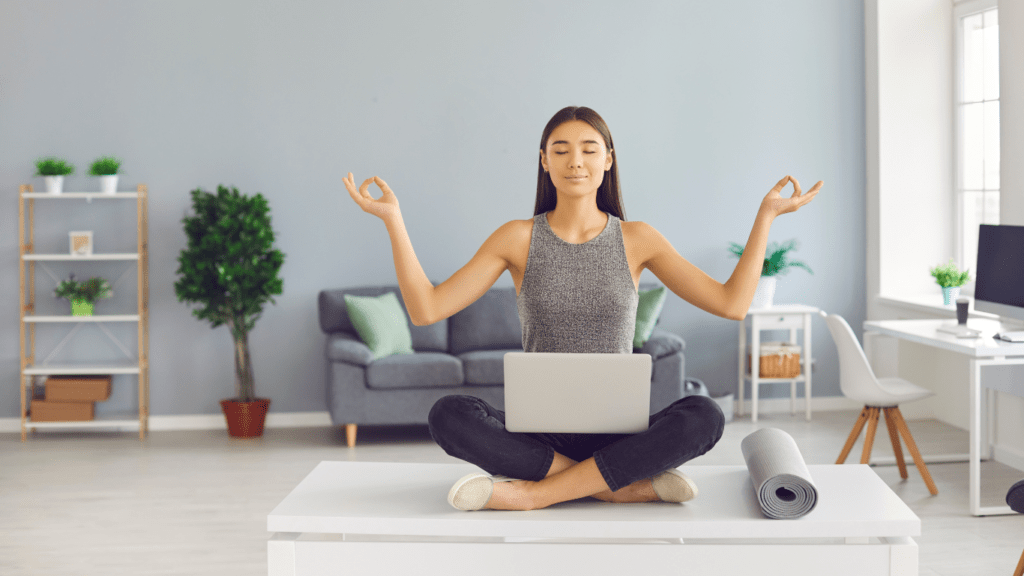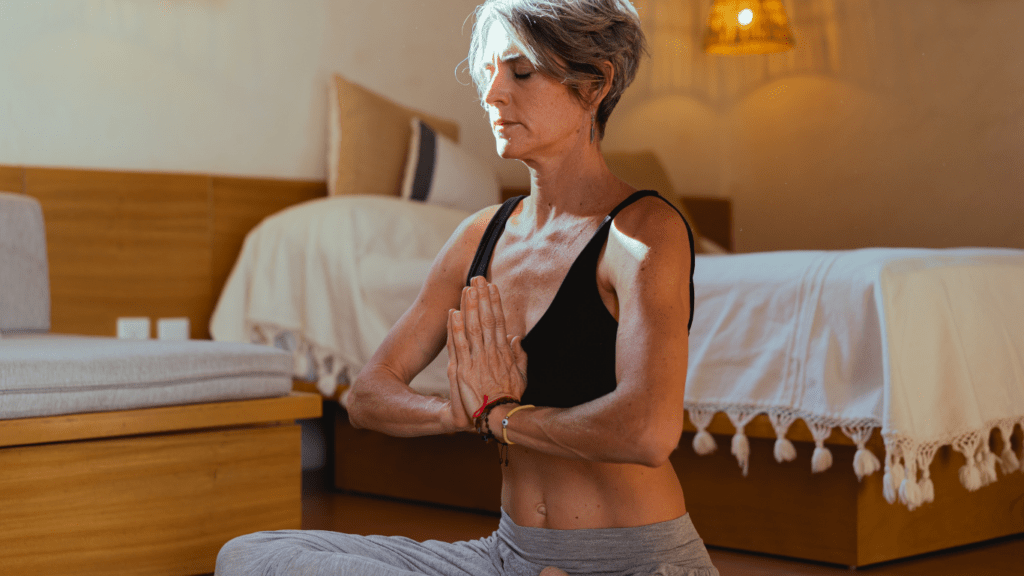Understanding Guided Meditation
Guided meditation involves following instructions provided by a narrator, either through an app, a recording, or a live session. This method helps users focus their mind, manage stress, and improve their emotional well-being. The guide often takes you through breathing exercises, visualizations, and specific mindfulness techniques.
The instructions generally direct attention to different parts of the body, creating a sequence that helps in releasing tension. Sessions might include nature sounds, soothing music, or affirmations to aid relaxation. This structured approach benefits beginners by providing a clear path to follow.
Guided meditation sessions typically last between 5 to 30 minutes, making them easy to fit into a daily routine. Some popular platforms for guided meditation sessions include Calm, Headspace, and Insight Timer. These platforms offer various themes such as sleep, stress reduction, and focus enhancement.
Unlike unguided meditation, guided meditation reduces the uncertainty of whether you’re ‘doing it right’. The consistent structure and positive reinforcement from the guide can make a significant difference, especially for those new to meditation practices.
Benefits of Guided Meditation
Guided meditation offers numerous benefits. Participants often experience improvements in mental and physical health and enhanced self-awareness.
Mental Health Improvements
Guided meditation positively impacts mental health. It reduces stress by helping individuals focus on the present moment through mindfulness techniques. Frequent practice decreases anxiety levels, promoting a sense of calm. According to the American Psychological Association, consistent mindfulness meditation reduces depression symptoms in various cases. Cognitive function improves as well, with enhanced concentration and memory retention.
Physical Health Benefits
Guided meditation benefits physical health. Regular sessions lower blood pressure and improve heart rate variability, enhancing cardiovascular health. Participants enjoy better sleep quality due to relaxation techniques integrated into sessions. The Mayo Clinic links meditation with reduced chronic pain, especially in conditions like fibromyalgia and arthritis. Immune function strengthens too, with a boost in antibody production reported with consistent meditation practice.
Enhanced Self-awareness
Guided meditation enhances self-awareness. Users develop a deeper understanding of their thoughts and emotions through focused introspection. This awareness aids in recognizing and altering negative thought patterns, fostering personal growth. Studies published in the journal Mindfulness show increased emotional regulation among regular meditators. Self-awareness also promotes greater empathy and compassion towards oneself and others, enhancing interpersonal relationships.
These benefits make guided meditation a powerful tool for improving overall well-being.
How to Start Your Guided Meditation Practice

Starting a guided meditation practice can be straightforward with a few essential steps. Here, I’ll outline key factors to help you get started effectively.
Choosing a Guide or App
Select a suitable guide or app to set the foundation. Popular apps like:
- Calm
- Headspace
- Insight Timer
offer diverse themes and session lengths to cater to various needs. It’s important to explore several options to find the one that resonates with you. Focus on the narrator’s voice, the structure of the sessions, and additional features like background music or nature sounds. Your comfort with the chosen platform enhances your overall experience.
Setting Up Your Space
Create a peaceful environment to facilitate your practice. Choose a quiet space free from distractions, ensuring it’s comfortable and inviting. Using a cushion or chair for proper support helps maintain good posture. Consider dimming the lights and incorporating elements such as candles, plants, or essential oils to make the space more soothing. A consistent meditation spot signals your brain it’s time to relax and focus.
Selecting the Right Time
- Incorporate meditation into your routine by selecting a convenient time.
- Early mornings or before bedtime are favorable since they provide a calm atmosphere.
- Consistency is crucial; meditate daily at the same time to build a habit.
- Start with shorter sessions, around 5 to 10 minutes, and gradually increase the duration as you become more comfortable.
- Aligning meditation with your daily schedule makes it easier to sustain the practice long-term.
Types of Guided Meditation Techniques
Guided meditation offers various techniques to cater to individual needs. Exploring different styles can help find the best fit.
Mindfulness Meditation
Mindfulness meditation focuses on present-moment awareness. In guided sessions, a narrator aids attention to breath, body sensations, or thoughts. This practice reduces stress by grounding individuals in the here and now. Many apps include mindfulness meditations, covering topics from anxiety to sleep.
Body Scan Meditation
Body scan meditation enhances awareness of physical sensations. Guided instructions lead attention through each body part, from head to toe. This technique alleviates tension and promotes relaxation. It’s particularly beneficial for those experiencing chronic pain or stress. Sessions often last 30 minutes, making it ideal for evening relaxation.
Loving-Kindness Meditation
Loving-kindness meditation cultivates feelings of compassion and love. Guided narrations encourage repeating phrases like “May I be happy” to foster positive emotions. By visualizing sending love to oneself and others, this technique can improve self-esteem and interpersonal relationships. Such sessions range from brief 5-minute practices to longer, more in-depth sessions.
Tips for a Successful Guided Meditation Routine
Consistency and patience are essential when establishing a guided meditation routine. Tracking progress can also significantly enhance the experience.
Consistency is Key
Consistency in meditation practice fosters familiarity and routine, making it easier to maintain. I try to meditate at the same time every day, whether it’s in the morning to start the day right or in the evening to wind down. Allocating a specific time slots meditation into my daily schedule. Frequency matters, so even a few minutes daily holds more value than occasional lengthy sessions. Consistent practice also helps build mindfulness, rendering it an integral part of daily life.
Be Patient with Yourself
Setting realistic expectations prevents discouragement during meditation practice. Progress may be slow, but patience is crucial. Immediately mastering meditation isn’t typical; it often involves gradually becoming more comfortable with the process. During challenging sessions, I remind myself that being present, regardless of distractions, contributes to long-term benefits. Celebrating small victories, such as staying focused for a few minutes longer, encourages continued effort and improvement.
Track Your Progress
Tracking progress provides tangible evidence of growth and improvement. I use meditation apps like Calm or Headspace to log sessions and monitor streaks. Journaling post-meditation reflections allows for recognizing patterns and areas for growth. Writing down feelings, challenges, and improvements offers insights into the practice’s evolution. Seeing progress documented motivates continued engagement and highlights the meditation’s positive impact over time.



 Mindfulness & Nature Wellness Specialist
Eve Macleod is a certified mindfulness and meditation instructor who has spent years cultivating her passion for connecting wellness practices with the natural world. At Whisper Forest Ways, Eve focuses on guiding readers through techniques that harness the power of nature to promote mental, emotional, and physical well-being. Specializing in forest bathing, nature-based meditation, and eco-therapy, Eve helps readers discover how nature can enhance mindfulness practices and deepen relaxation. She believes that the natural world holds untapped potential for personal healing, stress relief, and spiritual growth, and through her articles and tutorials, she invites everyone to embark on a journey toward a more peaceful and centered life.
Mindfulness & Nature Wellness Specialist
Eve Macleod is a certified mindfulness and meditation instructor who has spent years cultivating her passion for connecting wellness practices with the natural world. At Whisper Forest Ways, Eve focuses on guiding readers through techniques that harness the power of nature to promote mental, emotional, and physical well-being. Specializing in forest bathing, nature-based meditation, and eco-therapy, Eve helps readers discover how nature can enhance mindfulness practices and deepen relaxation. She believes that the natural world holds untapped potential for personal healing, stress relief, and spiritual growth, and through her articles and tutorials, she invites everyone to embark on a journey toward a more peaceful and centered life.
